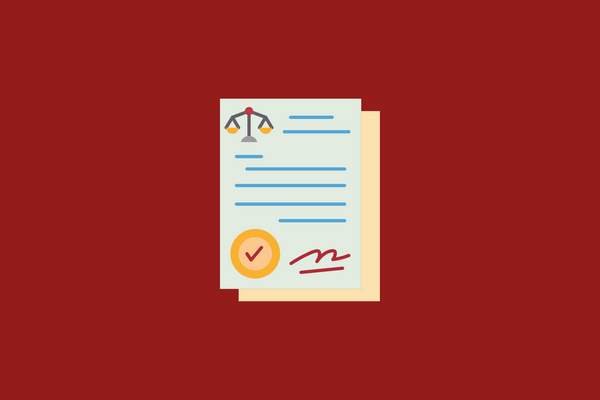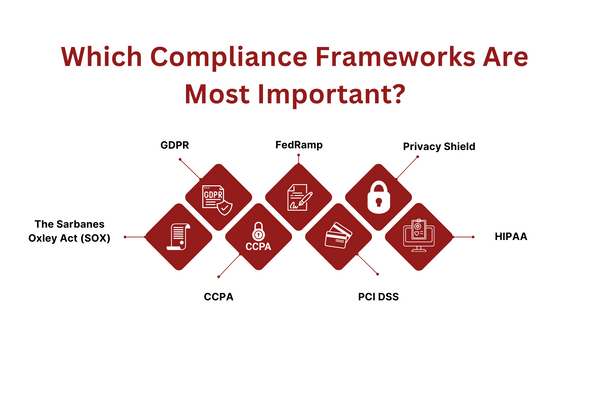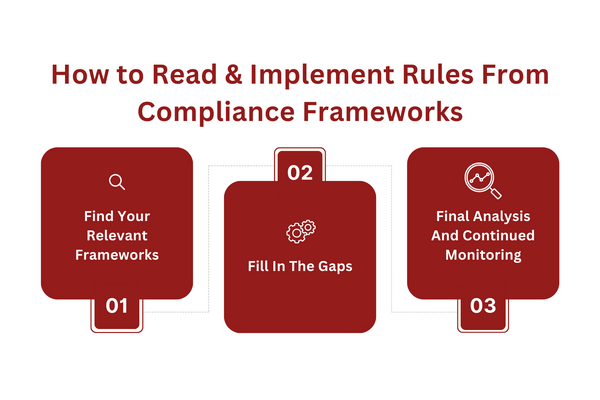
No matter who you are or who you work for, you must ensure your business complies with all legal regulations. A compliance framework helps you do just that.
This guide will cover what a compliance framework does for your business, what frameworks are essential, and how to implement them. After reading, you’ll understand and be able to utilize a compliance framework in your business operations.
Let’s get started.
What is a Compliance Framework?
In simple terms, a compliance framework is a guideline for businesses. It merges all the regulations and mandates that apply to your business to create a unified set of rules. By following specific industry frameworks, you can ensure that your business is compliant.
Regulations can come from laws, codes, contracts, citations, and doctrines. The information and rules on these documents can be overwhelming and sometimes needs clarification. A compliance framework will outline specific rules you will need to follow to ensure corporate compliance.
By following a compliance framework, your business will easily pass audits and avoid penalties.
Why is a Compliance Framework Important?

Compliance frameworks are guidelines for your business to follow that will ensure you comply with the regulations affecting your industry. They are designed by government bodies and agencies to save you time creating your compliance programs.
If you are in charge of your business’s compliance program, a compliance framework is the first place to start. The framework will outline an orderly and coherent list of requirements and standards your business must meet.
By following the framework’s guidelines, you ensure compliance with all relevant legislation, and rules while saving time and effort.
Auditors, managers, and business partners might review your business to check its compliance. They will likely use the same framework to judge your business in these cases. By using that framework as a base when creating your program, there will be no issue proving your complete compliance.
Most of these frameworks also outline the resulting penalties a business may incur if they do not comply. Typically, the penalties are hefty fines that can damage your business’s finances and reputation. In other cases, executives and managers can be found directly responsible and face personal punishments.
Which Compliance Frameworks Are Most Important?

There are widely known frameworks to help your business ensure compliance. These compliance framework examples include essential regulations to protect consumers’ sensitive data and financial reporting.
You should ensure your business complies with these frameworks and can use them as a base to create your own compliance program.
The Sarbanes Oxley Act (SOX)
The Sarbanes Oxley Act outlines how business transparency and accounting should look. When the law was made, there were several cases of corporate fraud, so this regulation was put in place as a response.
Businesses can face fines, and upper-level management can even be held personally responsible for not complying.
GDPR
The General Data Protection Regulation was put into place by the European Union (EU). The regulation sets firm rules on how businesses handle the data of consumers and employees.
The regulation dictates how businesses handle the data, gives consumers more control over their data, and requires companies to report security incidents.
The regulation applies to all businesses within the EU and any business that does business in the EU. A business with EU consumers is also subject to the regulation.
CCPA
The California Consumer Privacy Act (CCPA) is one of the most relevant business frameworks for data privacy. Any business that interacts with consumers in California is subject to its regulations.
The CCPA grants consumers extensive rights and allows them more control over their data. Businesses must give consumers the rights detailed in the CCPA and be transparent about selling and using the consumers’ information.
FedRamp
The Federal Risk and Authorization Management Program (FedRamp) is a framework that United States federal agencies use to keep their data secure when using cloud services.
If your business deals with a Federal Agency or any of their data, you will need to comply with and follow the guidelines of FedRamp.
HIPAA
The Health Insurance Portability and Accountability Act (HIPAA) is a significant healthcare industry framework. It regulates any business that collects and stores sensitive health data of consumers, such as hospitals or pharmacies.
PCI DSS
The Payment Card Industry Data Security Standard (PCI DSS) is a general framework that applies to any business that holds consumer credit card information. The PCI DSS is not a law, but businesses will still face fines for not complying.
Privacy Shield
The Privacy Shield is relevant to any business dealing with consumers or other businesses in the EU. The Privacy Shield protects the transfer of data between EU and your business. If you follow its framework, you can ensure you are also meeting the laws put in place by the EU.
How to Read & Implement Rules From Compliance Frameworks

Implementing the rules from a compliance framework is simple but requires consistent effort and follow-up to succeed. You can follow these four steps to ensure compliance and effective framework implementation.
Find Your Relevant Frameworks
The first step is to find the frameworks that are relevant to your business and the regulations you must meet. Compliance frameworks are centered around specific fields and objectives, so it is important to research the framework that suits your requirements.
You can also talk to a compliance consultant to see which frameworks apply to your business.
Fill In The Gaps
The second step is the actual implementation of the framework’s rules. Now you must address the discrepancies that you recorded in the last step. In this step, you have to create new policies and options or increase existing processes to match the requirements in the framework.
If the framework dictates you must provide a certain option to consumers or have a certain process in place in the case of a security breach, add it.
If your business only performs this many security checks a month, but the framework dictates you need more, increase your security checks. These are just examples, but you must meet the requirements as such.
Final Analysis And Continued Monitoring
After successfully implementing the new procedures, you now have to look at your compliance protocols as a whole. The last step is to ensure that your new processes do, in fact, meet the requirements detailed in the framework. You can repeat step two and compare the framework with your business’s new protocols.
Your job is not done after you ensure complete compliance and successful implementation of the rules. The laws and regulations that dictate compliance are constantly changing. For this reason, it is up to you to ensure your business’s protocols and compliance stay up to date.
One option to ensure this continued compliance for your business is to outsource with CaaS.
Compliance as a Service (CaaS) is the service provided by other businesses that will ensure your business’s continued compliance for you. CaaS uses cloud-based technology to ensure your business’s compliance with updated regulations.
CaaS can allow you to focus on your business’s primary operations while letting a third party with trusted software manage and ensure full compliance.
Compliance Framework Implementation Examples
Using the compliance framework for your business as a guideline, there are several ways to implement the rules into your business. These examples are meant to create a business-wide standard of compliance and show you tangible ways to implement the rules of a framework.
The first example is a policy that emphasizes your business’s commitment to compliance. Your policy should be a statement that outlines the main idea behind your business’s compliance program and the steps you take to achieve it.
To ensure the employees of your business follow the policy and maintain compliance in their work, the next example is to create procedures. These procedures will outline how employees should act in certain situations to remain in line with the policy.
The policy and procedures you implement will depend on the regulations outlined in the compliance frameworks. What procedures you implement should match closely with the framework’s guidelines.
For example, the CCPA includes giving consumers the right to “opt-out” of selling their information. Following the guidelines of the CCPA, your procedure could be to send a consumer an email containing the opt-out option after they make a purchase.
Review your frameworsk closely and only create the necessary procedures to ensure your business’s compliance.
FAQs
What does the compliance framework include?
A compliance framework will include all of the specific rules and regulations are taken from relevant legislation/industry standards and the specific protocols and processes your business has to comply with the standards.
Who is responsible for the compliance framework?
Compliance frameworks are created by government bodies and agencies, and they are responsible for updating them.
However, everyone who works for a business subject to industry regulations is responsible for adhering to the framework. If the framework is not upheld, the company as a whole, executives, and managers will be held accountable.
What is the difference between a compliance framework and a risk management framework?
A compliance framework are guidelines for a business to follow to ensure they remain in accordance with industry standards and laws.
These regulations are often in place to prevent risk, protecting consumers and their information. However, a risk management framework is focused on anticipating and taking preventative measures to eliminate the danger of risks.
Closing
Now that you know everything there is to know about compliance frameworks, it is time to try to review which ones apply to your business. After finding frameworks that apply to you, you want to compare their details to your current practices and make up for any discrepancies.
With Captain Compliance, you can ensure you meet industry laws and regulations while still being able to dedicate the necessary time and effort to other business operations.